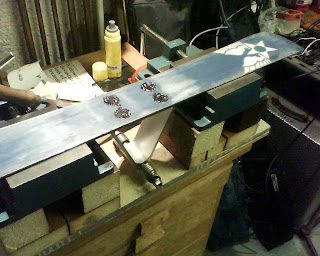It is too long and boring a story to explain how I got into this situation, rather than use screws to mount my skis to their adapters, I had installed recessed
T-Nuts into the base.
T-Nuts are used in pa speakers to hold the drivers to the baffle board. You can't fault their strength, they are immensely strong, but pretty they are not. I had previously used the last of my stock of repair candles to fill in the holes, but it didn't last well as the resulting surface was brittle and waxy.
I have been keen to try out a new type of repair strip sourced from
JibTuning which melt into place with the heat from a soldering iron or similar hot implement. The main advantage is that the resulting repair is supposed to be as good as the original surface, plus you can fill deep gouges in a single pass, rather than having to build up layers.
 |
| T-Nuts installed in ski core |
For someone who has made a lot of microphone leads over the last 20 years, the soldering iron is a familiar tool, but I would suggest you don't use your best one for this job, as it will spoil the tip. I used an old 25 Watt version and it worked well enough, they can be bought on-line for under $5 these days. Of course there are also purpose made tools for this job geared towards the professional user.
 |
| P-Tex repair strips - bases filled |
Once the surface has been filled it needs to be left for an hour or so to cool, after which you can level off with a metal file. Fine finishing can be accomplished with production sandpaper, I have previously used a cork block with the sandpaper. On this occasion I tried out a Sandvik Sandplate recently donated when a neighbour cleared their garage. Unfortunately this product is now discontinued but the similar
NT Cutter Plate is available in the USA from
here. I found that sandpaper could be wrapped around the Sandplate and made for quick work levelling the repairs.
Time will tell how long this fix will last against rocks and other obstacles I seem to have a knack for running over (usually sideways), but initial impressions are that the repair is much stronger than the old candle based system.













